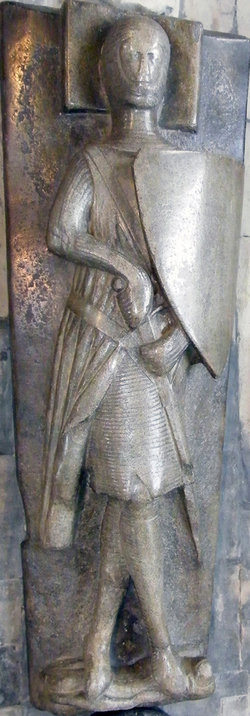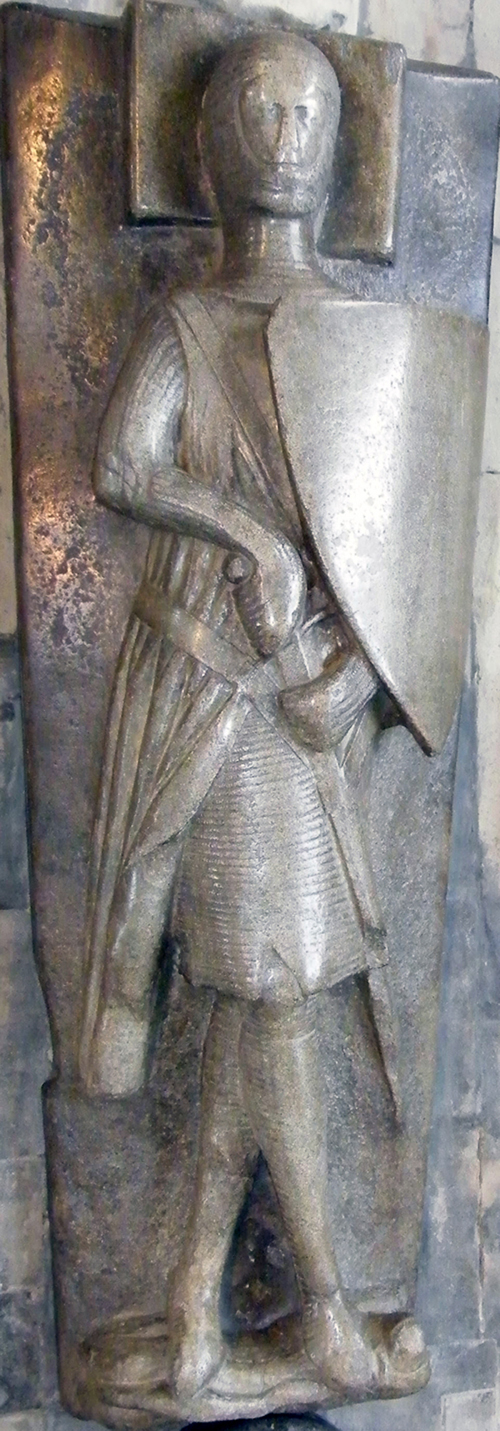Sir William was the son of William Longespée, 3rd Earl of Salisbury, and Ela, 3rd Countess of Salisbury. His death became of significant importance to the English psyche, having died as a martyr due to the purported mistakes of the French at the Battle of Mansurah, near Al-Mansurah in Egypt.
William made a pilgrimage to the Holy Land in 1240, and again in 1247. The second time, he proceeded to Rome and made a plea to Pope Innocent IV for support:
The Charter for the town of Poole issued by Longespée
"Sir, you see that I am signed with the cross and am on my journey with the King of France to fight in this pilgrimage. My name is great and of note, viz., William Longespée, but my estate is slender, for the King of England, my kinsman and liege lord, hath bereft me of the title of earl and of that estate, but this he did judiciously, and not in displeasure, and by the impulse of his will; therefore I do not blame him for it. Howbeit, I am necessitated to have recourse to your holiness for favour, desiring your assistance in this distress. We see here (quoth he) that Earl Richard (of Cornwall) who, though he is not signed with the cross, yet, through the especial grace of your holiness, he hath got very much money from those who are signed, and therefore, I, who am signed and in want, do intreat the like favour."
Having succeeded in gaining the favour of the Pope, Longespée raised a company of 200 English horse to join with Louis IX on his crusade. To raise funds for his expedition, he sold a charter of liberties to the burgesses of the town of Poole in 1248 for 70 marks. During the Seventh Crusade, William commanded the English forces. He became widely known for his feats of chivalry and his martyrdom. The circumstances of his death served to fuel growing English animosity toward the French; it is reported that the French Count d'Artois lured Longespée into attacking the Mameluks before the forces of King Louis IX arrived in support Robert d'Artois, William and his men, along with 280 Knights Templar, were killed at this time.
It is said that his mother, Abbess Ela Longespée, had a vision of the martyr being received into heaven by angels just one day prior to his death. In 1252, the Sultan delivered Longespée's remains to a messenger who conveyed them to Acre (Akko) for burial at the church of St. Cross. However, his effigy is found amongst family members at Salisbury Cathedral, in England.
William married Idoine de Camville, daughter of Richard de Camville & Eustacia Basset. They had two sons and two daughters:
Ida Longespée, who married Walter FitzRobert Lord of Dunmow
Ela Longespée, married James De Audley (1220–1272), son of Henry De Audley and Bertred Mainwaring
William III Longespée, whose daughter Margaret married Henry de Lacy, 3rd Earl of Lincoln
Richard Longespée
Sir William was the son of William Longespée, 3rd Earl of Salisbury, and Ela, 3rd Countess of Salisbury. His death became of significant importance to the English psyche, having died as a martyr due to the purported mistakes of the French at the Battle of Mansurah, near Al-Mansurah in Egypt.
William made a pilgrimage to the Holy Land in 1240, and again in 1247. The second time, he proceeded to Rome and made a plea to Pope Innocent IV for support:
The Charter for the town of Poole issued by Longespée
"Sir, you see that I am signed with the cross and am on my journey with the King of France to fight in this pilgrimage. My name is great and of note, viz., William Longespée, but my estate is slender, for the King of England, my kinsman and liege lord, hath bereft me of the title of earl and of that estate, but this he did judiciously, and not in displeasure, and by the impulse of his will; therefore I do not blame him for it. Howbeit, I am necessitated to have recourse to your holiness for favour, desiring your assistance in this distress. We see here (quoth he) that Earl Richard (of Cornwall) who, though he is not signed with the cross, yet, through the especial grace of your holiness, he hath got very much money from those who are signed, and therefore, I, who am signed and in want, do intreat the like favour."
Having succeeded in gaining the favour of the Pope, Longespée raised a company of 200 English horse to join with Louis IX on his crusade. To raise funds for his expedition, he sold a charter of liberties to the burgesses of the town of Poole in 1248 for 70 marks. During the Seventh Crusade, William commanded the English forces. He became widely known for his feats of chivalry and his martyrdom. The circumstances of his death served to fuel growing English animosity toward the French; it is reported that the French Count d'Artois lured Longespée into attacking the Mameluks before the forces of King Louis IX arrived in support Robert d'Artois, William and his men, along with 280 Knights Templar, were killed at this time.
It is said that his mother, Abbess Ela Longespée, had a vision of the martyr being received into heaven by angels just one day prior to his death. In 1252, the Sultan delivered Longespée's remains to a messenger who conveyed them to Acre (Akko) for burial at the church of St. Cross. However, his effigy is found amongst family members at Salisbury Cathedral, in England.
William married Idoine de Camville, daughter of Richard de Camville & Eustacia Basset. They had two sons and two daughters:
Ida Longespée, who married Walter FitzRobert Lord of Dunmow
Ela Longespée, married James De Audley (1220–1272), son of Henry De Audley and Bertred Mainwaring
William III Longespée, whose daughter Margaret married Henry de Lacy, 3rd Earl of Lincoln
Richard Longespée
Advertisement
Advertisement


